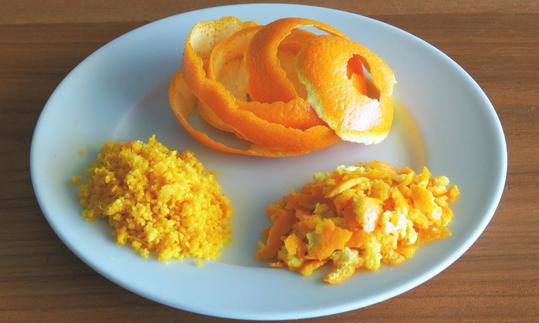Table of contents
Orange peel is used raw and only in organic quality to flavor hot and cold dishes. The zest refines pastries, sauces and drinks, among other things.
Use in the kitchen
Can you eat orange peel? You can eat orange peel. It tastes sweet and sour and fruity and tart and can be used in many different ways in the kitchen. Can you eat treated orange peel? You should only use peel from untreated organic oranges ( Citrus sinensis). Harmful, chemical-synthetic pesticides and coatings are prohibited in organic farming. Oranges from conventional farming, on the other hand, are often treated with them.
Fresh orange peel is obtained by washing an untreated organic orange under hot water and using a peeler to peel the peel into more or less wide strips as required. This works best if you peel off very thin strips with a zester or finely grate the peel with a household grater. Be careful not to remove the white part under the skin as it tastes bitter. Is dried orange peel edible? Dried orange peel (grated) can be bought in most supermarkets, and 6 g of orange zest is roughly equivalent to the grated peel of an orange.
The taste of orange peel is particularly popular in sweet pastries, desserts and drinks, but it also gives savory, salty dishes a pleasant sweet and sour aroma. The peel refines cakes (e.g. Happy Birthday Carrot Cake), tarts (e.g. carrot cake with walnut base), cookies and creams. It is also very popular in all kinds of Christmas recipes such as gingerbread, punch and mulled wine - together with cinnamon and cloves. But orange peel also gives soups (e.g. with pumpkin, carrots, potatoes or sweet potatoes) a pleasant fruity taste. Sauces with orange peel go perfectly with vegetables, vegan meat alternatives (e.g. sliced meat) or pasta (e.g. with onions and tomatoes). Raw orange peel also tastes wonderful in salad dressings and vinaigrettes (e.g. with mustard).
Spices and herbs such as chili, cumin, ginger, fennel seeds or basil harmonize very well with orange peel. The Japanese spice mixture Shichimi Togarashi is a classic table spice that is served with many dishes. In addition to dried orange peel, it contains chili, Sichuan pepper, sesame and nori.
Fresh, raw orange peel can be used to make orange sugar, salt, pepper or herb oil. To do this, put the peel in a can of sugar, salt,pepper or a bottle of oil. This not only produces food that tastes like oranges, but also makes fresh orange peel last longer. The shelf life of the peel can also be extended by making candied orange peel from it.
Raw orange peel is also ideal as a decoration on all kinds of vegan dishes or as a cocktail garnish. You can also make tea with dried orange peel (see the chapter "Tea preparation").
Possible uses and recipe ideas for oranges (without peel) and orange juice can be found in the corresponding article.
Making your own dried orange peel
Dried orange peel is easy to make yourself. Rinse organic oranges with hot water, rub dry and separate the peel with a peeler, zester or grater. Orange peel can be dried in the air or in the oven. For oven drying, put the peel on a baking tray lined with baking paper in the oven at 40 °C (raw food quality) and leave to dry for 4-5 hours. The oven door should be left ajar, e.g. by using a wooden spoon wedged between them. For air drying, it is best to lay strips of peel on a wooden board and turn them several times a day. After 2-3 days, the strips should be completely dry - you can tell by their brittle consistency. Dried orange peel will keep for several months if packed airtight.
Vegan recipe for pumpkin and orange peel soup
Ingredients (for 4 people): 500 g pumpkin (pulp), 250 g potatoes (starchy), 1 onion, 1 clove of garlic, 2 cm ginger, 2 tbsp rapeseed oil, 750 ml vegetable stock, 2 organic oranges ( juice and zest), 1 tsp paprika powder, a little salt and chili powder.
Preparation: Cut the peeled and seeded pumpkin into cubes. Peel and dice the potatoes, onion, garlic clove and ginger. Heat the rapeseed oil in a pan and sauté the onion, garlic and ginger. Pour in the vegetable stock and orange juice and bring to the boil. Add the pumpkin and potato cubes. Simmer the soup for 20 minutes and puree finely. Add the orange zest and paprika powder and season with salt and chili powder. Divide the vegan pumpkin and orange peel soup into four bowls and decorate withpumpkin seeds and thyme if necessary.
Tea preparation
ingredients: 1 cup (approx. 200 ml) hot water, 1-2 teaspoons dried orange peel (organic).
Preparation: Pour boiling water over dried orange peels, cover and leave to steep for approx. 8-10 minutes. Stir and strain. Sweeten to taste with agave syrup. The orange peel tea can also be brewed with a cinnamon stick or a few slices of ginger.
Vegan recipes with orange peel (raw) can be found under the note: " Recipes that have the most of this ingredient ".
| Not only vegans or vegetarians should read this: Vegans often eat unhealthily. Avoidable nutritional errors. |
Purchasing - Storage
Grated, dried orange peel can be bought in supermarkets such as Coop, Migros, Spar, Aldi, Lidl, Rewe, Edeka, Hofer and Billa. Denner and Volg rarely sell dried orange peel, especially in the run-up to Christmas or during special weeks. You can find it in organic quality in organic supermarkets such as Denn's Biomarkt and Alnatura. Online shops and occasionally health food stores also have dried, ground orange peel on offer. Some supermarkets (e.g. Coop, Spar, Edeka) also offer candied orange peel cubes.
The availability of orange peel (raw) varies depending on the size of the store, catchment area, etc. Our recorded food prices for the DA-CH countries can be found above under the ingredient image - and by clicking on them you can see their development at various suppliers.
Storage tips
Grated or peeled orange peel should be used immediately. However, it can be preserved by drying. Once dried, it will last for several months in an airtight container.
Ingredients - Nutritional values - Calories
The energy content of orange peel (raw) is 97 kcal per 100 g. Fat is barely present at 0.2 g/100g. They contain 25 g/100 g carbohydrates and 1.5 g/100 g proteins. The fiber content is 11 g/100 g. 1 The following are three notable orange peel ingredients (nutrients).
Does orange peel contain vitamins? With 136 mg/100g (170% of the daily requirement), orange peel is particularly rich in vitamin C (ascorbic acid). Lemon peel contains a similar amount at 129 mg/100g. Raw oranges contain significantly less of the vitamin at 53 mg/100g. Even more vitamin C can be found in yellow bell peppers (184 mg/100g). 1
Raw orange peel contains 161 mg calcium per 100 g (20% of the daily requirement). A similar amount can be found in lemon peel (134 mg/100g), much less in oranges (40 mg/100g). Fennel seeds contain significantly more at 1196 mg/100g. 1
Orange peel also contains 30 µg of folate (folic acid) per 100 g (15% of the daily requirement). Oranges (raw) have a comparable content (30 µg/100g). Lemon peel contains slightly less (13 µg/100g). Yeast extract (spice paste) contains a lot of folate at 3786 µg/100g, but only very small amounts are used. 1
The complete ingredients of orange peel (raw), the coverage of the daily requirement and comparison values with other ingredients can be found in our nutrient tables. In the article Nutrients explained you will get a detailed insight into the topic.
Health effects
Are orange peels healthy? The extract from the peel of oranges ( Citrus sinensis) has a variety of medicinal properties. It has a diuretic effect, strengthens the immune system, digestive system and skin and can help with stomach upsets and scours. It is also used to treat and prevent vitamin deficiencies, colds, flu and scurvy and to fight viral and bacterial infections. 2
A 2020 study investigated the effects of butanol extracts, aqueous extracts and hesperidin obtained from orange peels on inflammatory conditions of the digestive system such as gastric ulcers and hepatotoxicity (damage to liver epithelial cells caused by toxic substances). All three active ingredients tested showed significant antioxidant, anti-inflammatory, hepatoprotective and digestive system protective effects against harmful effects caused by chemicals, such as hepatotoxicity caused by paracetamol or gastritis and subsequent ulceration caused by ethanol. 3
The essential oil from the peels of oranges, limes and lemons showed antimicrobial activity against the foodborne pathogens Escherichia coli, Staphylococcus aureus, Salmonella typhi, Shigella spp. and Candida albans in a 2015 study. 4 A 2016 in vitro study reported the antimicrobial effect of orange peel against caries pathogens. Clinical in vivo studies are necessary to confirm effectiveness in practice. 2
You can find out more about the health benefits of oranges (without peel) and orange juice in the related articles.
Dangers - Intolerances - Side effects
An allergic reaction to oranges usually results in oral allergy syndrome, which manifests itself as a furry feeling on the tongue, swelling of the lips or the formation of blisters on the skin and mucous membranes. Allergic symptoms can sometimes only appear one or two days after consumption. Fructose intolerance triggers similar symptoms. An intolerance to the preservatives and pesticides contained in the oranges can also trigger the symptoms. 5
Is orange peel poisonous? Citrus fruits from conventional cultivation are often heavily treated with preservatives (eg thiabendazole, orthophenylphenol, imazalil) and coating agents (eg polyethylene wax oxidate), so eating the peel is not recommended. 5 The use of pesticides that are harmful to the environment and health is another reason to turn your back on conventionally grown oranges. The regulations are stricter for oranges from controlled organic cultivation. But even with organic oranges, it is advisable to wash the fruit before eating.
The citric acid contained in oranges attacks tooth enamel. You should not brush your teeth (with too much pressure) after eating or drinking acidic foods, as this will cause the upper layers of the teeth to wear down more. Instead, we recommend rinsing your mouth with water. This dilutes the acid and speeds up the replacement of dissolved minerals. 6
Folk medicine - natural healing
Chewing on organic orange peels helps to eliminate bad breath. However, due to the citric acid it contains, which attacks tooth enamel, you should not do this too often and wait to brush your teeth afterwards.
Ecological footprint - animal welfare
The ecological footprint of a food depends on various factors. The type of agricultural production (conventional vs. organic), seasonal, regional or domestic production or import by truck, ship or plane, different types of packaging and whether the goods are fresh or frozen all play a decisive role. According to a German study from 2020, the CO 2 footprint of raw oranges is 0.3 kg CO 2 eq/kg, according to "The Big Climate Database" it is 0.81 kg CO 2 eq/kg. 7,8 We did not find any figures on the ecological footprint of orange peels in particular.
The total water footprint of a product is made up of the green, blue and grey water footprint. The green water footprint refers to the rainwater used to produce the product, i.e. water from precipitation that is stored in the root zone of the soil and absorbed, evaporated and transpired by plants. The blue water footprint is the amount of surface and groundwater needed to produce the product (e.g. from artificial irrigation). The grey water footprint describes the amount of freshwater that would be required to dilute water pollution caused by production and to assimilate pollutants in order to meet water quality standards. According to a Dutch study from 2011, a total of 560 litres of water are needed to produce 1 kg of oranges (green water footprint = 401 l/kg; blue water footprint = 110 l/kg; grey water footprint = 49 l/kg). 9
The pesticides used in conventional agriculture are often also found in the final product. Most of these pesticides are found on the peel, but can also get onto the flesh when peeling and cutting. 10 These chemical-synthetic pesticides not only have a negative impact on the environment, but also on human health. 11 When buying oranges (especially for use of the peel), you should choose fruit from organic farming, where the use of such chemicals is avoided.
The oranges available in DA-CH supermarkets come from southern Europe (Italy, Spain) or further afield. The long transport routes of imported oranges increase the burden on the environment. Regional and seasonal fruit is preferable from an environmental point of view. Anyone who still reaches for an orange every now and then should use it whole - that means using the peel too.
Worldwide occurrence - cultivation
The orange originates from the region between northeast India and southwest China. It has been known there for over 4000 years. The Portuguese brought oranges to the Mediterranean region around 1500. From there they spread all over the world. Oranges grow mainly in the subtropics, and sometimes in the tropics. A large proportion of the commercial plantations can be found north and south of the equator in a belt between the 20th and 40th parallels. 12
According to the FAO ( Food and Agricultural Organization of the United Nations), 75.5 million tons of oranges were produced worldwide in 2021. After bananas and apples, oranges are the third largest producer in the world. The largest producers are Brazil, followed by India, China, Mexico, the USA and Spain. In Europe, after Spain, Italy and Greece are the main producers. 13
Further information
The orange ( Citrus sinensis) belongs to the genus Citrus and comes from the rue family (Rutaceae). It is the result of a natural cross between a mandarin ( Citrus reticulata) and a grapefruit ( Citrus maxima). 14
Sweet oranges are divided into four groups: common oranges (blond oranges or round oranges), navel oranges, pigmented oranges (blood and half-blood oranges) and acid-free oranges (sugar oranges). 14
Other related species of the genus Citrus are: lime ( C. latifolia and C. aurantiifolia), lemon ( C. limon), clementine ( C. clementina), pomelo ( C. grandis), grapefruit ( C. paradisi) and bitter orange ( Citrus aurantium).
Whether the citrus plants mentioned are valid species in the botanical sense is controversial. Some are of the opinion that there are only three valid basic species of the genus Citrus, namely citron ( C. medica), mandarin ( C. reticulata) and grapefruit ( C. maxima) and that the rest are introgressive hybridizations of the basic species. Others include Mexican lime ( C. aurantiifolia), Micrantha ( C. micrantha) and Citrus halmii in the list of basic species in addition to the three species mentioned above. 15
Note: Since most of the plants mentioned are hydrides, i.e. new plants resulting from crossing different species, the correct botanical name is to place an "x" between the genus name and the species name, e.g. Citrus × sinensis for oranges.
Alternative names
Oranges are also known as Apfelsinen. The word is derived from the Low German Apel de Sina ("apple from China") and was used to distinguish it from the bitter orange, which had been known for longer. Later, the orange was called Apfel von Sina, Chinaapfel or Sineser Apfel. After that, Apfelsine became common in northern Germany and in the south of Germany people spoke of Oranges.
To distinguish it from bitter orange, the terms sweet orange or sweet orange are also used.
Grated orange peel is also called orange zest.
In English, orange peel is called orange peel. Orange peel is also sold commercially as orange zest, and the ground version is known as orange peel powder.
Other uses
Orange peels are used outside the kitchen, for example in the perfume industry, as a natural cleaning agent or as a raw material for fashion.
Bibliography - 15 Sources
| 1. | USDA United States Department of Agriculture. |
| 2. | Shetty S, Mahin-Syed-Ismail P, Varghese S, Thomas-George B, Kandathil- Thajuraj P, Baby D, u. a. Antimicrobial effects of Citrus sinensis peel extracts against dental caries bacteria: An in vitro study. J Clin Exp Dent. 2016: e71–e77. |
| 3. | Baker DHA, Ibrahim BMM, Abdel-Latif Y, Hassan NS, Hassan EM, Gengaihi SE. Biochemical and pharmacological prospects of Citrus sinensis peel. Heliyon. 2022;8(8): e09979. |
| 4. | Hasija S, Ibrahim G, Wadia A. Antimicrobial Activity of Citrus sinensis (Orange), Citrus limetta (Sweet Lime) and Citrus limon (Lemon) Peel Oil on Selected Food Borne Pathogens. International Journal of Life Sciences Research. 2015;3(3):35-39. |
| 5. | Medlexi de: Orange. 2021. |
| 6. | Wetzel WE. UGB-Forum Spezial: Von klein auf vollwertig. Zahnschäden: Nach der Nuckel- die Rennfahrerflasche? S. 19-20. |
| 7. | Reinhardt G, Gärtner S, Wagner T. Ökologische Fussabdrücke von Lebensmitteln und Gerichten in Deutschland. Institut für Energie- und Umweltforschung Heidelberg ifeu. 2020;1-22. |
| 8. | The Big Climata Database. Orange raw. |
| 9. | Mekonnen MM, Hoekstra AY. The green, blue and grey water footprint of crops and derived crop products. Hydrol. Earth Syst. Sci. 2011;15:1577–1600. |
| 10. | Li Y, Jiao B, Zhao Q et al. Effect of commercial processing on pesticide residues in orange products. European Food Research and Technology. 2011; 449-556. |
| 11. | Asghar U, Malik MF, Javed A. Pesticide Exposure and Human Health: A Review. Journal of Ecosystem & Ecography. 2016. |
| 12. | Aid Infodienst (Herausgeber). Exoten und Zitrusfrüchte. 4. Auflage. Druckerei Lokay e. K. Reinheim. Bonn. 2014. |
| 13. | FAOSTAT. Crops Oranges. 2021. |
| 14. | Geraci A, Di Stefano V, Di Martino E, Schillaci D, Schicchi R. Essential oil components of orange peels and antimicrobial activity. Nat Prod Res. 2017;31(6):653–9. |
| 15. | CABI Digital Library org: Citrus aurantiifolia (lime). 2019. |













Comments